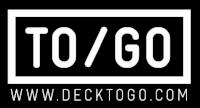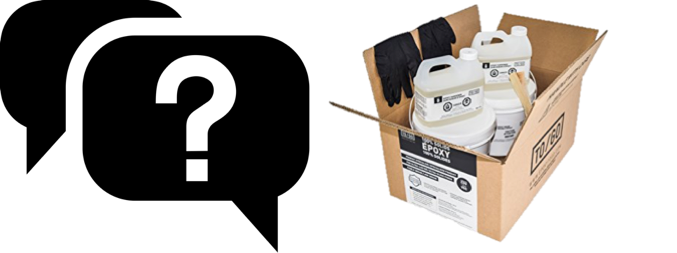ARE EPOXIES SAFE FOR HEALTH?
Other liquid and partially cured epoxy can give off potentially harmful chemical fumes, but fully cured epoxy poses few health risks. All TO / GO epoxy products are made in Canada and are 100% solids: solvent free and low odor, with excellent physical properties and a high gloss finish. This system has been approved by the Canadian Food Inspection Agency (CFIA). Unmatched durability, 100% solid TO / GO epoxy resists tires, oils and gasoline. This self-leveling epoxy for indoor use is the solution to protect your concrete floors from chipping.

WHAT ARE THE COMPONENTS OF EPOXY?
Epoxy consists of two components: a resin and a hardener. The resin in the epoxy floor is the clear or transparent component and virtually odourless. The hardener, meanwhile, is darker and has a strong smell, similar to ammonia. When these two components are mixed during the application process, a chemical reaction occurs.
ON WHAT TYPE OF SURFACE CAN WE USE EPOXY?
An epoxy coating provides a protective and aesthetic layer to any hard surface such as metal, tile, concrete or vinyl. We recommend using it on concrete. Please test the humidity level of your concrete prior to the application.
The different contexts of use of the epoxy: in a residential or professional garage floor, in a kitchen floor, a bathroom floor, a commercial floor, a hospital floor or in a school floor.
WHAT DOES THE TO/GO EPOXY KIT CONTAIN?Our epoxy kit contains the essentials you need to apply your epoxy: epoxy resin (3 L), epoxy hardener (1.5 L), the dye with selected color (16 oz), a stirring rod and nitrile gloves. We offer a range of 50 colors including 26 standard colors, 4 pearlescent colors, 5 safety colors and 15 metallic colors.

WHAT IS THE COVERAGE FROM AN TO/GO EPOXY KIT?
|
Standard colours (first epoxy coat) |
About 400 sq. ft. (5-mil thick) |
|
Standard colours (second epoxy coat) |
Maximum 250 sq. ft. (8-mil thick) |
|
Clear epoxy on smooth surface |
About 250 sq. ft. (8-mil thick) |
|
Clear epoxy on textured surface (flakes) |
About 100 sq. ft. (20-mil thick) |
|
Safety colours |
Maximum 125 sq. ft. (16-mil thick) |
|
Metallic colours |
Maximum 60 sq. ft. (32-mil thick) |
HOW TO PREPARE THE EPOXY APPLICATION SURFACE?
Proper surface preparation is crucial. The concrete must be clean, dry and free of oil and contaminants. This is the most important step to have a great finished product.
CLEANING: Clean the surface using a concrete preparation. Rinse thoroughly and leave to dry for at least 48 hours. For stubborn oil stains, use a degreaser.
SANDING: Resurfacing with a polisher is by far the best surface preparation method, but it can be replaced by sanding for most residential projects. Sand the surface using a sander fitted with 60-grit sandpaper to remove old paint.
REMOVING DUST: Remove all dust from the surface using a shop vacuum. Remove all contaminants or fine concrete dust from the surface.
FILLING CRACKS: Expand the cracks using a grinder to free up friable particles, and clean with the shop vacuum. Use a concrete filler. TO/GO 100% solids epoxy can be applied 4 to 6 hours later.

HOW TO PREPARE THE EPOXY MIXTURE?
Stir each component separately. Pour the epoxy hardener (component B) in the epoxy resin (component A) into a pail. Mix well for 4 minutes at a low speed (300 to 450 RPM) using a drill fitted with a mixer. Do not mix at a high speed to prevent air entrapment bubbles. Scrape the sides and the bottom of the pail with a stir stick to get a homogeneous epoxy mixture. Let the mixture stand for 2 minutes. Apply all of the mixture within 30 minutes.
IMPORTANT! Mixing must be done in order for the epoxy hardener to have a uniform effect. The epoxy must be applied within 30 minutes of mixing.


WHAT ABOUT THE COLOUR?
There are 2 types of situations: either it is a ready-mixed colour or it is a personalized colour.
If the colour is ready-mixed, you only need to stir it a little before adding the hardener. If the colour is personalized, you have to pour all of the tint in the epoxy resin container (component A). Mix, scraping the sides and bottom of the bucket to get a homogeneous colour. If a coat requires more than one 4.5 L container, mix the containers together in a 5-gallon pail and pour back into the original containers according to volume.

HOW TO APPLY THE EPOXY?
Pour the epoxy directly onto the floor in consecutive and parallel strips. Using a brush, quickly cut in the edges. Then, using a squeegee, spread he epoxy and back roll (left to right, then toward you). It is important to get a uniform epoxy coating and avoid creation of puddles.

RECOMMENDATIONS: Do not touch up the epoxy after 10 minutes. Wear spiked shoes to walk on the coated floor. Apply a coat of clear epoxy on dark or metallic colours. Apply a second epoxy coat between 24 and 48 hours later to get a very glossy and uniform finish. If the second coat must be applied more than 48 hours later, sand the surface using a sander fitted with grit sandpaper to remove the gloss and avoid any adherence problems.




IMPORTANT! The epoxy will start to cure quickly after 40 minutes and will be completely unusable after 50 minutes.
WHAT IS THE DRYING TIME?
Allow a minimum of 24 hours before permitting foot traffic and a minimum of 48 to 72 hours before permitting vehicles on it. The temperature and humidity will affect the curing time.

IS THE EPOXY EASILY DAMAGED?
No, it isn’t, an epoxy floor is very resistant. However, it can be deteriorated in the long run if heavy objects frequently fall on it.
CAN WE STAIN EPOXY?
Epoxy has exceptional resistance, so oils and fluids cannot penetrate its surface. In addition, the epoxy is resistant to chemicals. There are however some substances that are likely to stain your epoxy floor, such as animal urine, cola or soft drinks. Finally, the sun can in the long run yellow epoxy.
HOW TO CLEAN AN EPOXY FLOOR?
For minor spills or vehicle drippings, simply wipe them up with a paper towel or other soft cloth. Routine maintenance cleaning is best achieved with either a soft bristle broom or a commercial dust mop. For heavy cleaning of a soiled epoxy floor, sweep away any loose debris and then mop floor with a hard foam mop with hot water and ammonia. If desired, the floor can be hosed out and squeegeed dry. Do not use abrasive cleaning chemicals on the coatings, or any cleaners that contains acids (citrus cleaners, vinegar, etc.) or soap-based cleaners. Soap based cleaners leave a residue on the floor that not only detracts from the shine, but also become increasingly slippery should the floor get wet.

HOW TO REMOVE EPOXY?
It is possible to remove the epoxy with a sandblaster.

IS EPOXY SLIPPERY?
If the epoxy floor is wet, yes, it is very slippery. However, to get an anti-skid surface, sprinkle quartz sand evenly within 60 minutes of applying epoxy. Back roll (left to right, then toward you). Adding a full coverage of decorative flakes reduces the slippery aspect.


HOW ARE THE DECORATIVE FLAKES APPLIED?
To add decorative flakes, sprinkle flakes evenly within 60 minutes of applying epoxy. Back roll (left to right, then toward you). Add at least one additional layer of clear epoxy to prevent flaking of the flakes. The amount of decorative flakes varies depending on the desired coverage.

WHAT QUANTITY OF DECORATIVE FLAKES SHOULD BE APPLIED AND WHY ARE THEY SOLD SEPARATELY AT TO/GO?
Amount of decorative flakes based on desired hiding level. In order to achieve a good job and to obtain great results, a large quantity of flakes is necessary. That is the reason why the flakes are not included in our epoxy sets but sold separately in 5-lb bags.
|
Hiding level |
Approximate percentage |
Approximate quantity |
|
|
Very light |
2 % |
0,3 lb |
0,125 kg |
|
Light |
5 % |
0,7 lb |
0,3 kg |
|
Medium |
12,5 % |
1,75 lb |
0,8 kg |
|
Intense |
25 % |
3,5 lb |
1,6 kg |
|
Very intense |
50 % |
7 lb |
3,2 kg |
|
Complete |
100 % |
15 lb |
7 kg |
WHAT ARE THE BENEFITS OF PUTTING FLAKES?
Using flakes when installing the epoxy helps to make the floor more durable and thus prevent it from deteriorating. In addition, the flakes allow the epoxy to be less slippery.
IS A COAT OF CLEAR NECESSARY AT THE END?
No, it is not necessary but it helps to get a lustrous and more resistant finish. On the other hand if you choose to put flakes a layer of clear is needed.

WHAT IS THE DIFFERENCE BETWEEN A STANDARD EPOXY AND A METALLIC EPOXY?
If you choose a metallic epoxy you will need a greater amount of epoxy to cover the same surface (for example a 4.5L epoxy kit of standard colored will cover approximately 400 sq. ft. and will have a 5 mil-thick against a recovery of 60 sq. ft. and a 32 mil-thick for a metallic color). In addition, the installation of a metal epoxy requires a different tool kit.Finally, it is primarily a question of taste because the finish differs between a metallic color and a standard color.
SHOULD THE SURFACE WHERE THE EPOXY IS APPLIED BE COMPLETELY FLAT OR CAN IT BE TILTED SLIGHTLY?
On vertical or sloped concrete surfaces, apply thin coats of the epoxy to prevent sagging.
CAN WE USE PAINT ACCESSORIES TO APPLY EPOXY?
No, it requires specific accessories. For example, a roller not adapted to the epoxy will leave lint and a non-smooth rendering.

HOW IS THE DELIVERY DONE?
All our epoxy items are delivered in 3 working days by carrier in a reinforced box specially made for our products. In case of defect or damaged products upon receipt of the package do not hesitate to contact us at info@decktogo.com, our customer service will be happy to help you and answer your questions in French, English and Spanish.

WHAT IS THE RETURN POLICY?
Only flakes are returnable in their original bag which must be intact. We will reimburse the cost – 20%. The customer must pay the shipping fee to return the flakes.

